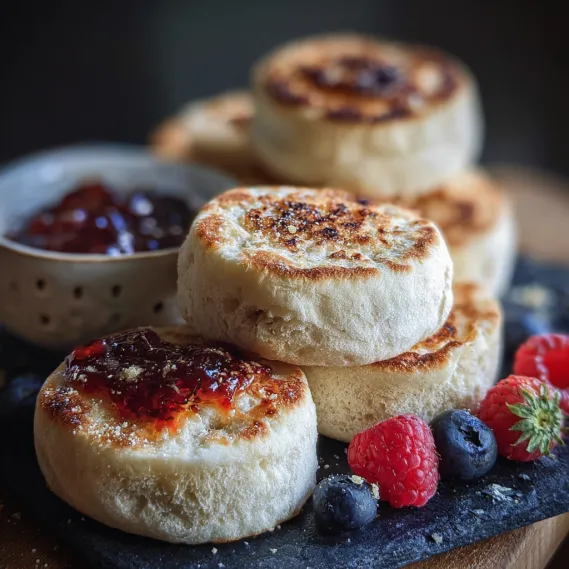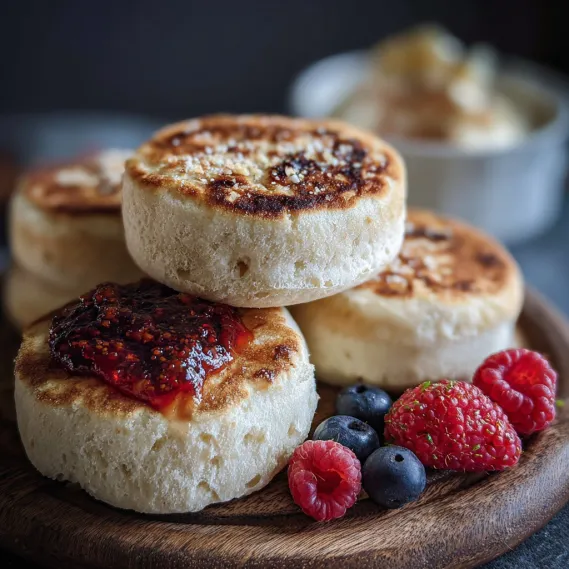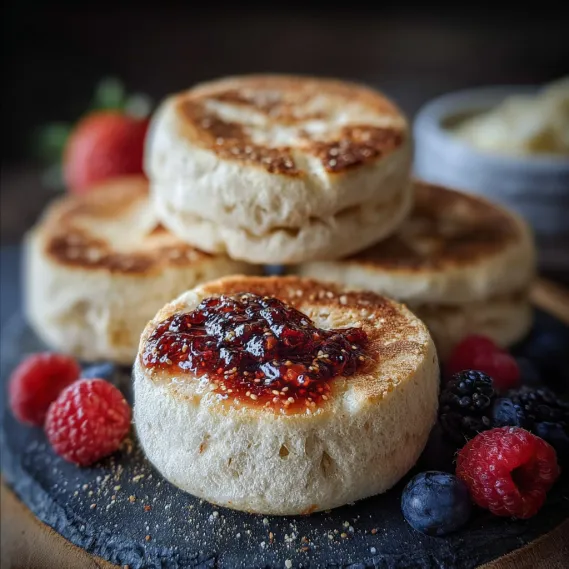 Pin
Pin
Sourdough English Muffins are one of those special weekend recipes I return to again and again. They use bubbly sourdough starter instead of commercial yeast, and with a long overnight rise, you wake up to dough ready to shape and cook right on the griddle. The taste is tangy, the inside is tender with classic nooks and crannies, and the process is surprisingly low effort for such satisfying breakfast food.
My family lights up when they see a batch of these cooling on the counter. I first tried making them after falling in love with the thick bakery-style English muffins at our local market and nothing compares to the home-cooked result.
Ingredients
- Sourdough starter: lively and fed six to eight hours before if possible as this gives the lift and flavor
- Honey: brings extra tenderness and a subtle depth you can use sugar or maple syrup if preferred
- Milk or nut milk: contributes richness for a fluffy crumb try reconstituted powdered milk or a 50 50 mix of yogurt and water for added tang
- Bread flour: gives structure and chewyness you can add up to two cups whole wheat for nuttiness
- Baking soda: helps lighten the dough during stovetop cooking and gives a classic lift
- Sea salt: sharpens the sour flavor and balances the honey opt for unrefined sea salt for rounder taste
- Cornmeal: keeps muffins from sticking and adds a signature crunch always choose fresh finely ground cornmeal
Step-by-Step Instructions
- Prepare the dough the night before:
- In a large mixing bowl stir the sourdough starter with honey then add milk and combine thoroughly. Sprinkle in about half the flour and mix well then add the rest and stir until you have a sticky dough. Cover tightly and leave to rise on the counter for 10 to 14 hours until puffy and slightly domed
- Incorporate leaveners in the morning:
- Sprinkle baking soda and salt evenly over the dough. Knead these in with clean hands gradually working in just enough flour so the dough becomes smooth and only lightly sticky. Form into a soft ball that is easy to handle
- Shape the muffins:
- Dust your work surface with flour. Roll the dough gently until about half an inch thick making sure not to press out all the air bubbles. Use a large round cutter to portion out muffins. Gently gather up scraps and reroll if needed
- Cornmeal stage and rest:
- Arrange muffins on a baking sheet generously sprinkled with cornmeal to prevent any sticking. Lightly dust tops with more cornmeal for texture. Let them rest for an hour to allow a final rise. If your kitchen is especially warm they may only need half this time
- Cook on the stovetop:
- Preheat a seasoned cast iron skillet or griddle over medium low heat for about five minutes until evenly hot. Carefully transfer muffins allowing space between them. Cook about 10 to 15 minutes per side until deeply golden brown. When flipping press gently to get more contact for a flat even cook
- Check doneness and finish:
- Muffins should reach about 200 degrees in the middle. If browning outside but still doughy inside transfer to a 350 degree oven for another 10 minutes. Let cool slightly before splitting with a fork for the best open crumb
 Pin
Pin
My favorite part is always watching the dough bubble and surge overnight. There is something magical about waking up to the promise of tangy homemade English muffins with coffee. My daughter loves to help sprinkle cornmeal and press her own muffin shapes and it has become a weekend tradition in our house.
Storage Tips
Freshly cooked muffins keep best in an airtight container at room temperature for up to five days. For longer storage freeze muffins whole or split for up to three months. Reheat right from frozen in a toaster for morning ease
Ingredient Substitutions
Swap out honey for maple syrup or plant based sweetener if making vegan. Any milk works well from dairy to oat or almond. Feel free to play with the ratio of whole wheat to white bread flour for different flavors and textures. Sprinkle extra seeds for a fun twist
 Pin
Pin
Serving Suggestions
Muffins are perfect split and toasted served with butter and berry jam or as part of a hearty breakfast sandwich with scrambled eggs and cheese. Try topping with smashed avocado or using as the base for classic eggs benedict when feeling fancy
Cultural and Historical Context
English muffins originally hail from 19th century Great Britain where they were griddled and sold street side to be eaten hot and crispy. Sourdough versions add a distinct American touch bringing characteristic tang and resilience to the recipe. Their nooks and crannies are tailor made for catching every drop of jam or honey
Recipe FAQs
- → How can I achieve the signature nooks and crannies?
Roll the dough to the correct thickness and use a fork to split baked muffins rather than slicing with a knife to preserve the classic holes and texture inside.
- → Can I substitute whole wheat flour?
Yes, you can swap in 1-2 cups whole wheat flour for a denser texture and rich flavor. Add wheat flour during the initial mix for best results.
- → How should I store the muffins?
Keep muffins in an airtight container at room temperature for up to 5 days, or freeze well-sealed for up to 3 months.
- → What’s the best way to cook them evenly?
Use a thick cast iron skillet or griddle, preheated to medium-low, for consistent, controlled heat that prevents burning and allows even cooking.
- → Is this method vegan adaptable?
You can use plant-based milk and swap honey with maple syrup or agave to make the muffins fully vegan-friendly.
